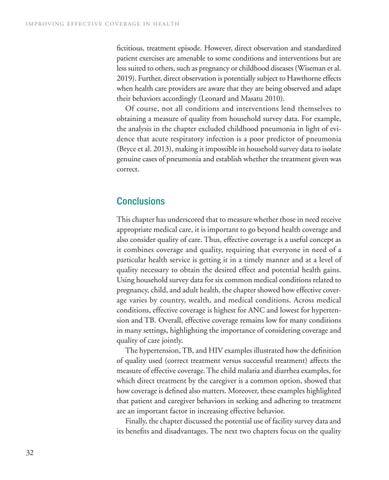IMPROVING EFFECTIVE COVERAGE IN HEALTH
fictitious, treatment episode. However, direct observation and standardized patient exercises are amenable to some conditions and interventions but are less suited to others, such as pregnancy or childhood diseases (Wiseman et al. 2019). Further, direct observation is potentially subject to Hawthorne effects when health care providers are aware that they are being observed and adapt their behaviors accordingly (Leonard and Masatu 2010). Of course, not all conditions and interventions lend themselves to obtaining a measure of quality from household survey data. For example, the analysis in the chapter excluded childhood pneumonia in light of evidence that acute respiratory infection is a poor predictor of pneumonia (Bryce et al. 2013), making it impossible in household survey data to isolate genuine cases of pneumonia and establish whether the treatment given was correct.
Conclusions This chapter has underscored that to measure whether those in need receive appropriate medical care, it is important to go beyond health coverage and also consider quality of care. Thus, effective coverage is a useful concept as it combines coverage and quality, requiring that everyone in need of a particular health service is getting it in a timely manner and at a level of quality necessary to obtain the desired effect and potential health gains. Using household survey data for six common medical conditions related to pregnancy, child, and adult health, the chapter showed how effective coverage varies by country, wealth, and medical conditions. Across medical conditions, effective coverage is highest for ANC and lowest for hypertension and TB. Overall, effective coverage remains low for many conditions in many settings, highlighting the importance of considering coverage and quality of care jointly. The hypertension, TB, and HIV examples illustrated how the definition of quality used (correct treatment versus successful treatment) affects the measure of effective coverage. The child malaria and diarrhea examples, for which direct treatment by the caregiver is a common option, showed that how coverage is defined also matters. Moreover, these examples highlighted that patient and caregiver behaviors in seeking and adhering to treatment are an important factor in increasing effective behavior. Finally, the chapter discussed the potential use of facility survey data and its benefits and disadvantages. The next two chapters focus on the quality 32

